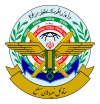Iran's military industry manufactures and exports various types of arms and military equipment. Iran's military industry, under the command of Iran's Ministry of Defence and Armed Forces Logistics, is composed of the following main components:
| Organization | Field of activity |
|---|---|
| Iran Electronics Industries | Electronics, communications, e-warfare, radars, satellites, etc. |
| Defense Industries Organization | Tanks, rockets, bombs, guns, armored vehicles, etc. |
| Aerospace Industries Organization | Guided missiles systems, etc. |
| Aviation Industries Organization | Aircraft, UAV, helicopters, etc. |
| Marine Industries Organization | Ships, hovercraft, submarines, etc. |
Security of Telecommunication and Information Technology (STI) is also part of the Iranian defense industry.
History
See also: List of military equipment manufactured in IranIran's military industry was born under the last Shah of Iran, Mohammad Reza Pahlavi. In 1973, the Iran Electronics Industries (IEI) was founded to organize efforts to assemble and repair foreign-delivered weapons. Most of Iran's weapons before the Islamic revolution were imported from the United States and Europe. Between 1971 and 1975, the Shah went on a buying spree, ordering $8 billion in weapons from the United States alone. This alarmed the United States Congress, which strengthened a 1968 law on arms exports in 1976 and renamed it the Arms Export Control Act. Still, the United States continued to sell large amounts of weapons to Iran until the 1979 Islamic Revolution.
In 1977, the Iranian Defense Industries Organization began to work on missiles jointly with Israel in Project Flower and requested a joint missile development program with the United States which was rejected. In 1979, the country took the first step into manufacturing by reverse engineering Soviet RPG-7, BM21, and SA-7 missiles.
After the Islamic revolution and the start of the Iran–Iraq War, economic sanctions and an international arms embargo led by the United States coupled with a high demand for military hardware forced Iran to rely on its domestic arms industry for repair and spare parts. The Islamic Revolutionary Guard Corps was put in charge of re-organising the domestic military industry. Under their command Iran's military industry was dramatically expanded, and with the Ministry of Defence pouring capital into the missile industry, Iran soon had an arsenal of missiles.
Since 1993, it also has produced its own tanks, armoured personnel carriers, missiles, a submarine and a fighter plane.
In 2007, following events in Iran's Nuclear Program, the United Nations Security Council placed sanctions on Iran forbidding it from exporting any form of weapons. Despite these sanctions, Iran sold some military equipment to countries such as Sudan, Syria and North Korea. Iran was also unable to import military equipment such as S-300 from Russia and went on to build its own substitute dubbed as Bavar 373.
On 2 November 2012, Iran's Brigadier General Hassan Seifi reported that the Iranian Army had achieved self-suffiency in producing military equipment, and that the abilities of Iranian scientists have enabled the country to make significant progress in this field. He was quoted saying, "Unlike Western countries which hide their new weapons and munitions from all, the Islamic Republic of Iran's Army is not afraid of displaying its latest military achievements and all countries must become aware of Iran's progress in producing weaponry." As of 2016, the Defence Ministry is collaborating with more than 3150 national firms as well as 92 universities.
Iran’s Defense Ministry claimed that it has begun manufacturing air defense laser cannons on 16 November 2019. On September 03, 2020, Iranian Defense Minister Brigadier General Amir Hatami said his country is capable of manufacturing more than 38,000 military equipment and hardware parts. In February 2023, Iran reported that had tripled its military products exports in 2022 while its self sufficiency in military needs had reached 93%. Iranian Defense Minister Mohammad Reza Ashtiani claimed in March 2024 an increase of 4 to 5 times in defense exports without specifying details.
See also
- Industry of Iran
- Iran Aviation Industries Organization
- Defense Industries Organization (DIO)
- Iran Electronics Industries (IEI)
Notes
- "Top World Powers Using Iranian Arms: IRGC Chief - Politics news".
- ^ "Iran Electronics Industries (IEI) | Iran Watch". Archived from the original on 2016-11-22. Retrieved 2015-04-08.
- "Iran Electronics Industries (IEI)". Archived from the original on 2007-10-19. Retrieved 2008-07-20.
- "Nuclear Threat Initiative". NTI: Nuclear Threat Initiative. Archived from the original on 18 June 2009. Retrieved 11 November 2014.
- "A Code of Conduct for Weapons Sales Video Transcript". Cdi.org. Archived from the original on 2006-03-08. Retrieved 2012-02-06.
- "NTI:Missile Chronology: 1960-1984". NTI: Nuclear Threat Initiative. Archived from the original on 18 June 2009. Retrieved 11 November 2014.
- "Procurement: November 3, 2004". Strategypage.com. 2004-11-03. Retrieved 2012-02-06.
- Dar Al Hayat
- "Iran Launches Production of Stealth Sub". Fox News. 2011-11-30. Archived from the original on 2011-02-08. Retrieved 2012-02-06.
- The Washington Post (November 15, 2007): "IAEA: Iran Providing 'Diminishing' Information on Its Nuclear Program", By Robin Wright
- Iran reports that Iran's Army has achieved self-suffiency in producing military equipment Archived November 8, 2012, at the Wayback Machine - Armyrecognition.com, November 5, 2012
- "Military to develop maritime cruise missile soon - Mehr News Agency". 21 August 2016. Archived from the original on 2016-09-10. Retrieved 2016-08-28.
- "Mass Production of Laser Cannons Starts in Iran". tasnimnews.
- "Iran Self-Reliant in Producing over 38,000 Military Gear Parts: Defense Minister". tasnimnews.
- "ЦАМТО / / Иран в 2022 году втрое увеличил экспорт вооружений".
- "Iran's Defense Minister Highlights Self-Sufficiency in Drone Engine Production". Tasnim News Agency. 2024-03-13. Retrieved 2024-03-18.
External links
- IRAN Defence Products
- Defense Industries Organization
- Iran Electronics Industries
- Iranian Aerospace Industries Organization
- Iran Aircraft Manufacturing Industrial Company
- Iran Defence links and news
- Iranian Military Pictures & videos
- Iranian Submarine Manufacturing
| Armed Forces |
|  | ||||||||||||||
|---|---|---|---|---|---|---|---|---|---|---|---|---|---|---|---|---|
| Other | ||||||||||||||||
| Defense industry of the World | |
|---|---|